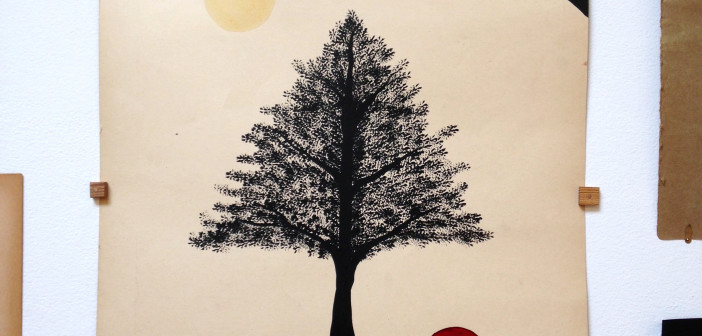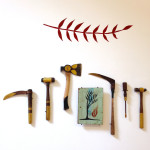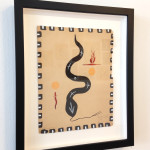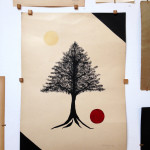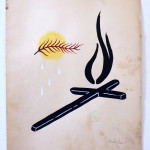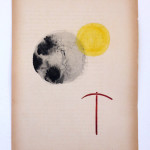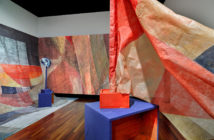Curiously familiar symbols on aged paper greet the viewer of Rich Cali's Poor Moon exhibition (on view through Oct. 24) at The Mingo Gallery in Beverly, MA. His work, made while on a cross-country journey from Texas to Massachusetts, plays with loaded imagery such as the scythe and the Christian cross, as well as more abstracted geometric symbols inspired from folk art, native American spirituality and Christianity. Other symbols commonly used in his work are more culturally generic, such as islands, trees and snakes. He uses a stark palette; they are mostly black and grey tones, with some washes of yellow-orange, gold and sanguine red. His imagery calls to mind silhouettes, contemporary signage, simple tattoos and 18th century profile portraiture. Written in soft penciled script in the corner of each work is the date, in Roman numerals, and location of when and where the work was created.
The aged look of the paper used in his work symbolically reference the passage of time, erosion, decay, aging and even antiquity—the pencil script adds to this impression. From a formal perspective, the brown color softens the starkness of the black silhouettes/symbols and makes them more visually appealing. The aged treatment adds poignancy to the symbols, something that might be lost should they be reproduced as a print series on white paper.
Cali includes an actual pair of unpainted antique scythes in the entrance window of the exhibition. Similarly, six rustic tools with touches of gold paint appear hung on the central wall. However, the presence of the scythes, as well as the painted tools, both reinforce and undermine the symbolic nature of the artwork, since the symbols on the paper are not meant to specifically refer to real world objects. While the symbolic associations of the scythe center around death, an actual scythe is used to harvest grains.
While overall Cali’s visual language is consistent and even enigmatic in its uncertain meanings, it is occasionally inaccessible; one finds few means to decode his symbolism that extend beyond our existing understanding of these somewhat generalized signs. Paradoxically, some symbols such as the campfire are too accessible; in their universality, they lose some of their strength. While the precisely delineated forms of Cali’s images such as the undulating snake or the growing tree reinforces their roles as symbols, they also prevent wanderings of the imagination. For example, the tree is a tree; we remain only to figure out the significance of the tree. An exception is in such works as Bar Harbor ME, IX/XV in which the incompleteness of one of the globes, alongside the balanced placement of the visual elements, engender a 'dialogue' of uncertainty. In short, Cali's symbolism represents an intriguing, if not enigmatic, logical system of language that frustrates more than inspires the viewer's understanding.
Paper Moon is on view at Mingo Gallery September 15 through October 24, 2015. To learn more, visit the gallery here.
- Rich Cali, Tool Installation, 2015, 8″ x 10″ painting on found wood, flanked by found antique farm tools, gold painted and etched, dimensions vary. Photo courtesy of Mingo Gallery.
- Rich Cali, Chicago IL & AP, XIII/XV, acrylic and ink on found antique paper, 8″ x 10″. Photo courtesy of Mingo Gallery.
- Rich Cali, Bradley Beach NJ, IX/XV, acrylic and ink on found antique paper, 16″ x 22″. Photo courtesy of Mingo Gallery.
- Rich Cali, Bradley Beach NJ, IX/XV, acrylic and ink on found antique paper, 9 1/4″ x 12″. Photo courtesy of Mingo Gallery.
- Rich Cali, Bar Harbor ME, IX/XV, acrylic and ink on found antique paper, 8 1/4″ x 11 3/4″. Photo courtesy of Mingo Gallery.

